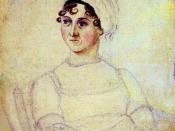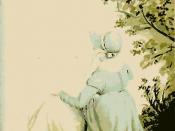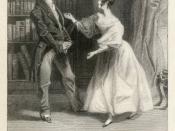Jane Austen's romantic novel, 'Pride and Prejudice', was written in the early 19th century. The role of women during this time was extremely different to the present day. One of the important obligations a woman had to carry out in that time was marriage. 'Pride and Prejudice' portrays many different perceptions on marriage, and is written often with irony and sarcasm. Austen also uses her own lifestyle to influence her writing, for example, Austen and her sister Cassandra had a very close and confidant relationship which is shown in Jane and Elizabeth's characters. Also, Jane Austen's father and her two youngest brothers became clergymen, two of her brothers became naval officers and one of her brothers was adopted by wealthy cousins into an opulent lifestyle. This is why Austen's novel, 'Pride and Prejudice' is written with such precision on not only the middle-class in which she grew up but in the higher-class world.
The first example of Jane Austen's presentation of marriage is that of Charlotte Lucas and Mr. Collins.
Mr. Collins is Mr. Bennet's cousin and as he is the nearest blood-related male he is the heir to the Longbourn estate, where the Bennet's live. Elizabeth describes him as 'a conceited, pompous, narrow-minded, silly man' and does not hesitate in rejecting him when he proposes to her. Mr. Collins is originally very shocked at his rejection expressing his egocentric behaviour and how he is oblivious to how people perceive him. He is incapable of believing that Elizabeth could actually be sincere in her refusal; this clearly demonstrates that he has little respect for Elizabeth and that he is entirely conceited. He immediately becomes very self defensive but doesn't seem to be too affected by the refusal as, when he comes to terms with it, he quickly proposes to Charlotte...


